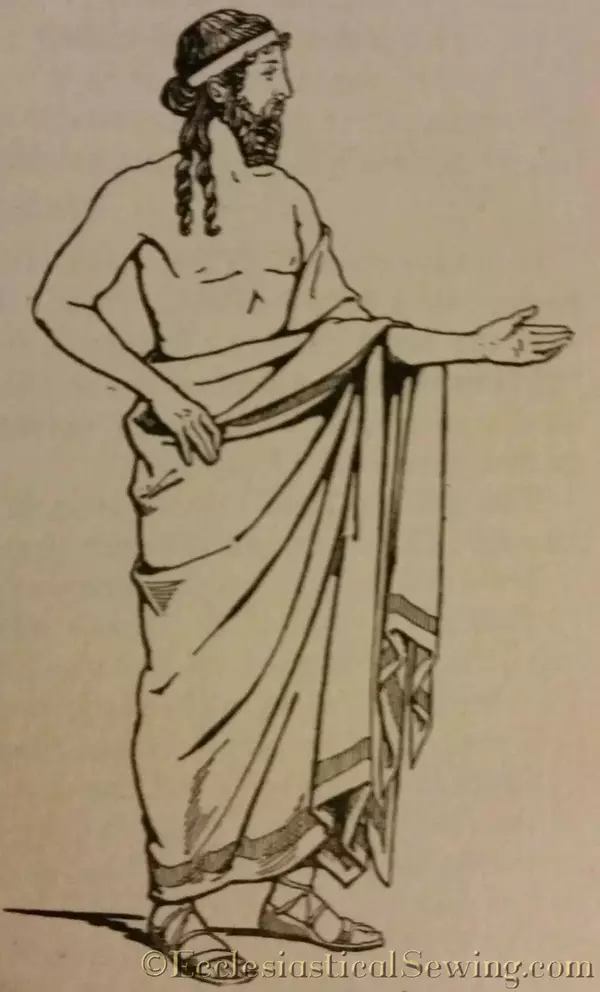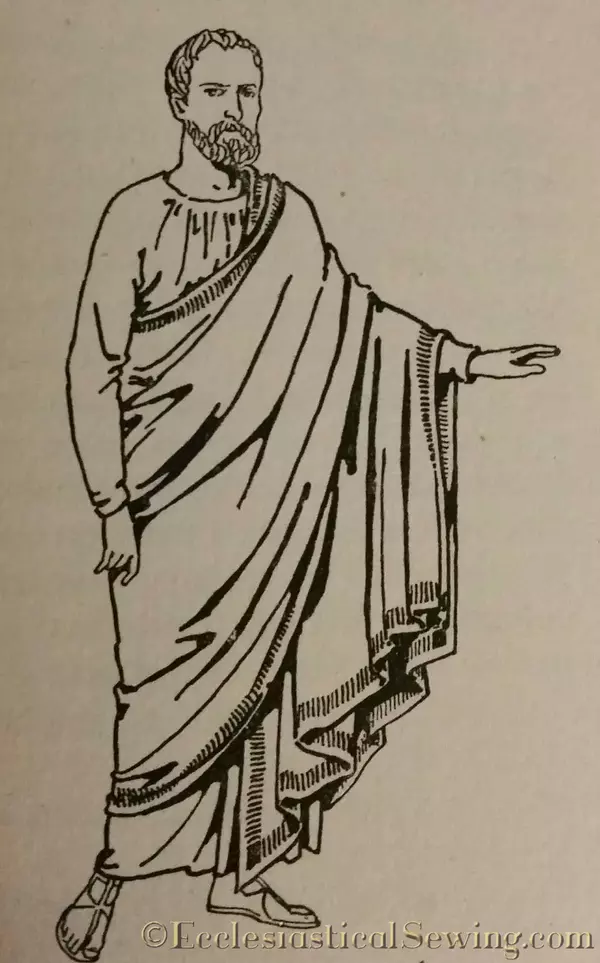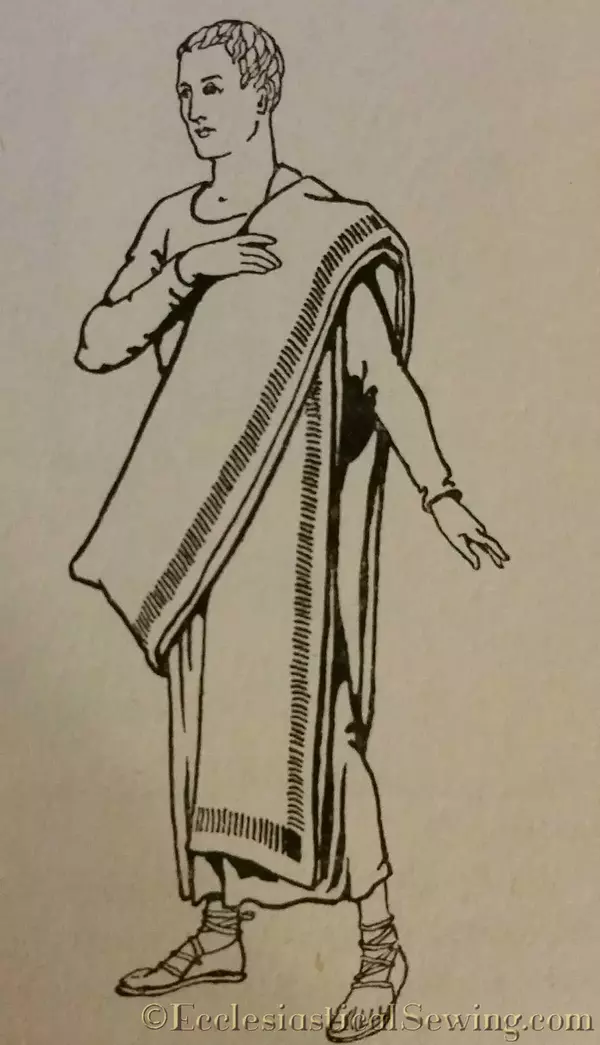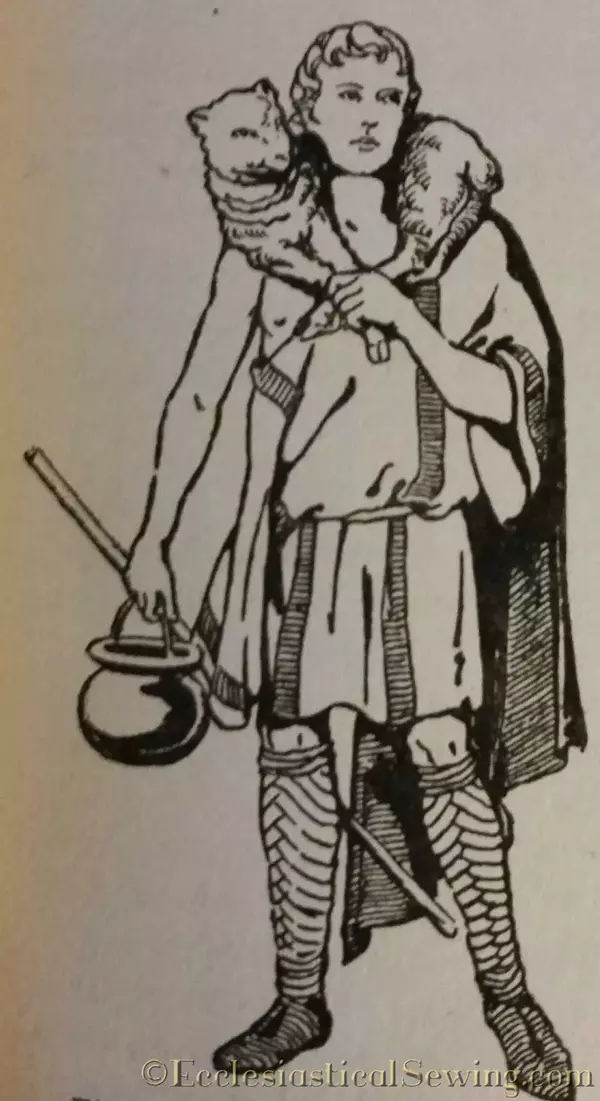The Pallium-Herbert Norris
The Pallium-Herbert Norris
History
The Pallium-Herbert Norris: From the 6th century till the 1st century B.C., the Greeks wore a particular linen or wool garment. People of the working class wore this garment over a kolobus–remember this is one of the predecessors to the alb. The overgarment was shawl-like in appearance, but much bigger than a mere shoulder wrap. It was called the himation. The himation was large enough to be draped over the left shoulder and arm, wrapping around the body on the right side. It was never worn in reverse (draping the right shoulder and arm and wrapping around the left side of the body).
1 Norris, Herbert. The Himation Norris Figure 13. 1950. Church Vestments: Their Origin & Development. New York: E. P. Dutton & CO. INC., 1950.
Distinct Attire
As said above, this was worn over and over garment by the working classes. Men of learning, however, such as philosophers or sages, wore only this garment. It was a mark of distinction. They, who did not do any sort of manual labor, were not at risk of exposing private areas throughout the day. Although perhaps a sign of wealth, comfort, and ease, it must be noted that with this life free of strenuous labor came the dedication to the learning and crafting of the mind and great thoughts. It cannot be said that the philosophers were lazy; they were most fervent in their pursuits.
2 Norris, Herbert. The Philosopher Norris Figure 15. 1950. Church Vestments: Their Origin & Development. New York: E. P. Dutton & CO. INC., 1950.
When the Romans took up the Greek lifestyle, they kept this garment as a sign of the philosopher–only changing the name to Pallium and wearing an alb beneath. It is suggested by Norris that Christ and His Disciples wore the pallium, draped over a type of undergarment.3 These lavish garments would have been labors of love from the band of women, who followed Christ. Norris argues there is no reason why Christ would have dressed as a peasant.
3 Herbert Norris, Church Vestments: Their Origin & Development (New York: E. P. Dutton & CO. INC., 1950), 22.
4 Norris, Herbert. The Folded Pallium Norris Figure 16. 1950. Church Vestments: Their Origin & Development. New York: E. P. Dutton & CO. INC., 1950.
From Imperial Insignia to Liturgical Vestment
By the 4th century A.D., the pallium had become the mark of a high officer of the empire and had ceased to be used by the commons. Although it was still a large garment in terms of the amount of fabric used, it was folded along the length, instead of hanging around the ankles as a robe. Here we can mark the cessation of this being a garment and the beginning of its use as merely an ornament. Once it became an ornament, we can officially mark its use as a church vestment circa 336-7 A.D. It was bestowed by Marcus, a Bishop of Rome, upon another bishop.
In the 5th century A.D., the pallium broke into two garments: the lorum used for secular or civil purposes and the other the church vestment known as the pallium. By this time, the garment was thinner in width almost scarf-like, and began to take the shape of the garment that we are familiar with today. The pallium was not used by all the clergy, only the pope or the archbishop wore this liturgical vestment. During the 6th century A.D., the custom became that the archbishop wore the pallium through the mass until the gospel had been read. A pope, however, kept the garment on throughout the whole service. There were, of course, disputes where archbishops wanted to keep the pallium on throughout the service.
Now a note on decoration: while the garment was a himation or early pallium, its bottom edges would have had borders. Around the 3rd century A.D., the white pallium would have had colored bottom edges and the new addition of a colored collar. As the liturgical vestment, it symbolized a shepherd with his lamb across his shoulders. It was therefore decorated with beautiful embroidery designs such as crosses or other designs appropriate to the season.
5 Norris, Herbert. The Good Shepherd Norris Figure 20. 1950. Church Vestments: Their Origin & Development. New York: E. P. Dutton & CO. INC., 1950.
The Symbolic Evolution
In the 9th century A.D., the church vestment known as the pallium underwent a transformation into a “Y” shape, intending to symbolize the idea of the Good Shepherd even more closely. The edge work on the white wool or linen was done in gold and there were six crosses placed on certain parts. This has not changed drastically in the years between up until our present era.
Here at Ecclesiastical Sewing, we find the history of such church vestments utterly fascinating. It is incredible how the robe that marked the Greek and Roman philosophers changed throughout the years to be the beloved pallium that adorns our ministers of the faith. Thank you for allowing us to share this valuable information with you! For more information on the pallium, please read the second chapter in Church Vestments: Their Origin & Development by Herbert Norris.
~Nihil Sine Deo~
Be sure to visit our online store front Ecclesiastical Sewing where you may shop for Liturgical Fabrics, altar linen fabrics, church vestment-making patterns, liturgical machine embroidery designs, church vestment trims and notions and so much more. You may also find us on Ecclesiastical Sewing on Facebook, Twitter, and Pinterest. Sign up for our mailing list at the bottom of the page on our online store front and receive a free copy of our Small Linens Booklet as our way of saying thank you for following along.
Bibliography
Norris, Herbert. Church Vestments: Their Origin & Development. New York: E. P. Dutton & CO. INC., 1950.
Headwear Part III: The Tiara–Norris
The Origins and History of the Alb
Headwear Part II: The Mitre–Norris
September 13th–John Chrysostom
The Pallium & The Ontological Argument










 RSS - Posts
RSS - Posts
You must be logged in to post a comment.